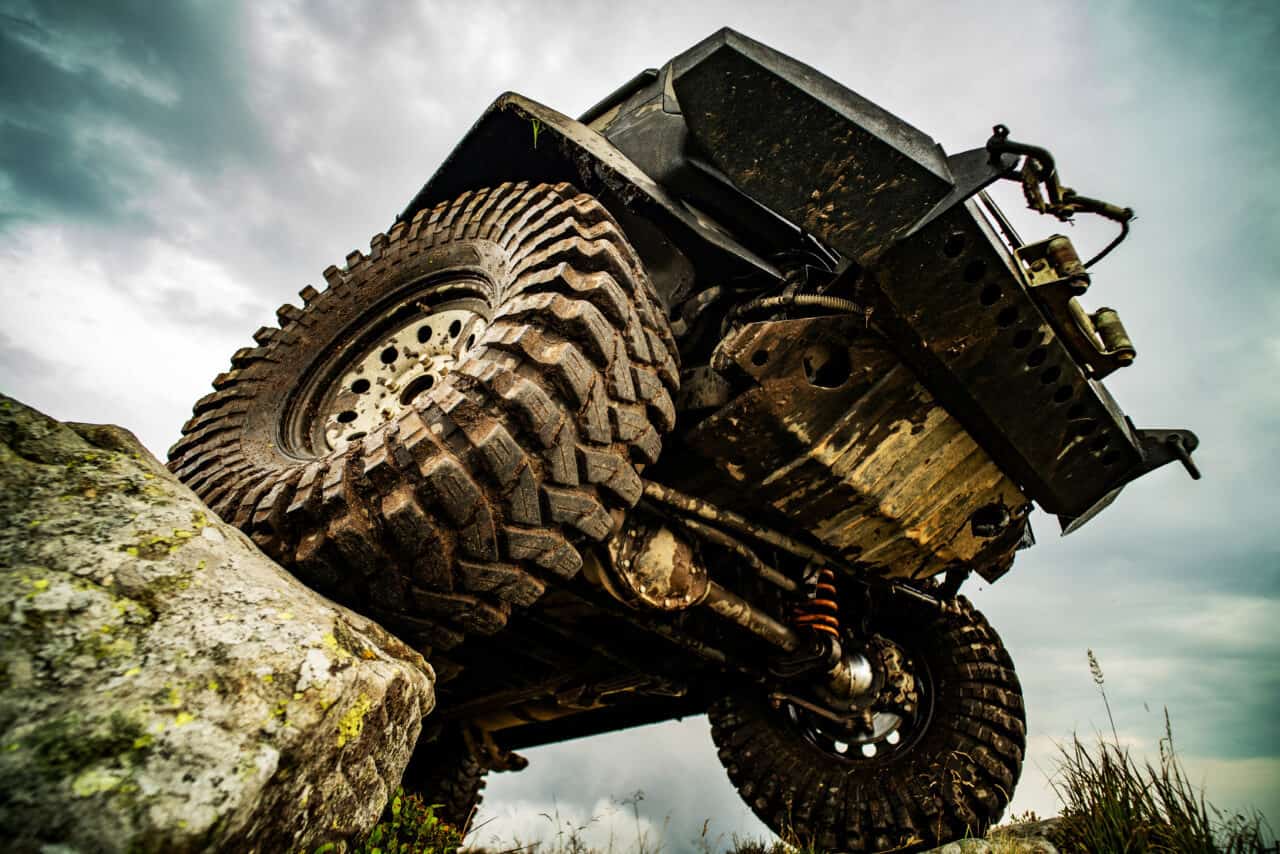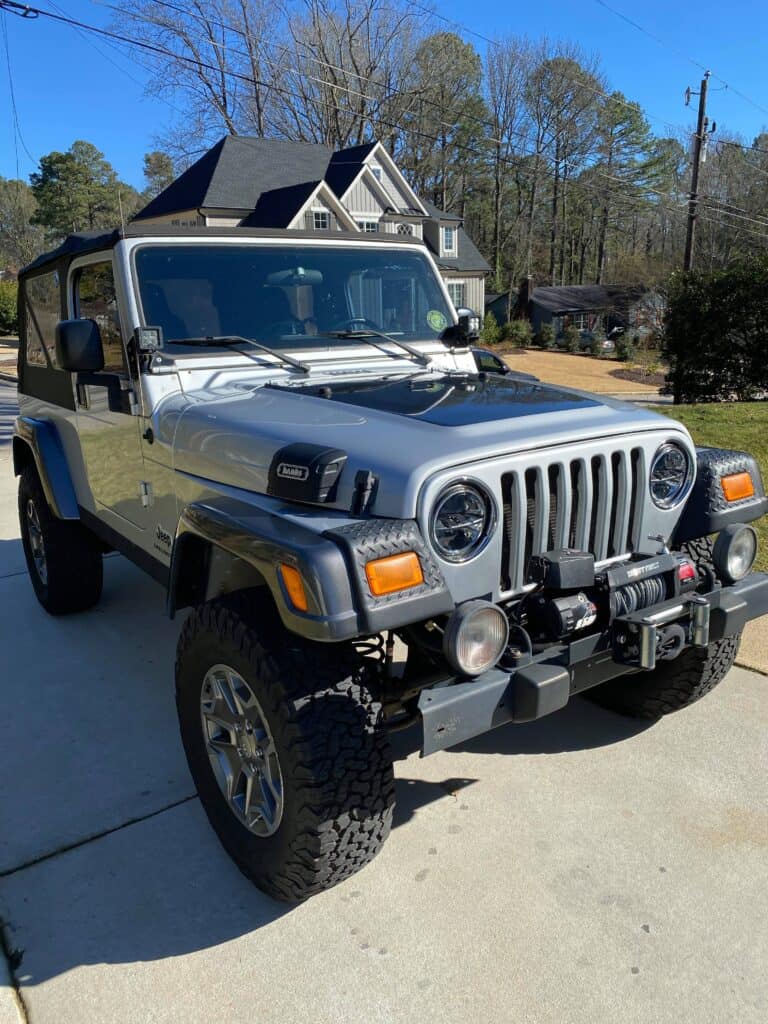Can You Fit 33 Inch Tires on a Stock Jeep JK?

The Jeep JK is one of the original models of the Wrangler off-roading vehicle. Although newer versions are bigger and have been optimized for off-roading, the older versions have enthusiasts wondering just how big of tires they can fit.
33-inch tires will fit on the Jeep Wrangler JK, but they may rub depending on where the vehicle is driven most often. If the 33-inch tires fit on the stock wheels then there will be minimal rubbing; however, if the tire requires rims larger than the stock wheel it will not fit without adjustments.
Upgrading to a larger tire set is one of the easiest ways to improve your vehicle’s off-roading abilities. However, how large of a tire you can add is limited by the space available in the wheel well. Keep reading to learn how to fit 33-inch tires on your Jeep Wrangler JK!
33 Inch Tires Stock
Every off-roader knows that bigger tires make for a better ride. The larger of tire you have on your Jeep JK the more clearance there is between the ground and the bottom of the vehicle allowing you to explore further than ever before. Bigger tires also provide better grip and handling.
Because larger tires are a must for off-roading, Jeep drivers rush to fit the largest tire they can find. Unfortunately, many run into the issue of the tire not actually fitting. While plenty of modifications can be done in order to make the new tire fit, this can cost a pretty penny.
If you want improvement to your vehicle’s off-roading ability without all the effort and cost of a lift kit, then running it stock is the best option. But, how big of tires can the Jeep JL run on stock?
The biggest issue with the Jeep JK is not actually the height of the tire but rather the width. Although increased width will aid in performance, it will also lead to serious rubbing and articulation issues. Even if the tire is as small as 30 inches tall, it could be too wide for the Jeep JK.
New tires should be no wider than the stock rims. If the tire is any wider than the stock rims, adjustments such as spacers will need to be made.
Using the stock rims, the largest tire that should be fitted on a Jeep Wrangler JK is a 33 inch. These tires will fit but may end up rubbing.
If the sway bars are disconnected for off-roading, there will be a much more significant amount of rubbing.
The stock set-up for the Jeep Wrangler JK features a 6.25 inch backspacing. Since backspacing is an extremely important factor, it is important to know how little is too little with bigger tires.
The front tires will have the least amount of clearance. This limited clearance is suitable for driving around town and will not result in any rubbing or decreased articulation; however, if you plan on taking your Jeep JK on unpaved roads, or where there are no roads, the rubbing will be too significant and could seriously damage your vehicle. Additionally, you will lose your ability to turn therefore limiting what areas are safe for you to explore.
Since the Jeep JK is designed specifically to drive in places that have never been driven, you do not want to do anything that limits where your Wrangler is able to travel. If 33-inch tires are a must for your off-roading activities, try a few of the modifications described in the section below so you can use them safely!
33 Inch Tires with Mods

While the ideal choice would be to use larger tires on the stock wheels and suspension, the stock bones can only fit tires so big. To go any larger than the 32 or 33-inch tire maximum, or to make the 33-inch work better for off-road, you will need to do some modifications on your Jeep Wrangler JK.
One method for increasing tire clearance on your Jeep Wrangler JK is to get a lift. Either a body lift or suspension lift kit will provide your Jeep JK with more tire clearance. Use a lift kit around two to three inches in order to gain the space without throwing off your vehicle’s center of gravity that could increase the risk of roll-over.
If you already have 33-inch tires fitted on your Jeep Wrangler JK, you may have already noticed the areas that rub most. Depending on how much rub there is and where it is located, you may be able to fix it with some simple trimming.
If your tires primarily rub on the fender flares you can trim away some of the plastic or get an after-market fender flare that will provide you with more space. Be careful when trimming your fenders to not remove too much plastic. Many states have restrictions and regulations for vehicle fenders.
In some states, only 3/4 of the tire needs to be covered while in others the whole tire must be enclosed. Be sure to check your state’s regulations before making any changes to your Jeep Wrangler JK’s fenders.
As for purchasing after market fender flares, look for a flare that gives you at least 4.5 inches of backspacing. This will allow you to have better clearance and more articulation while off-roading.
While it is not necessary to increase both the width and height of your Jeep’s tires, wider tires will help provide more stability for the added vehicle height.
If you end up choosing tires that are wider than what comes stock, you will need to upgrade the size of your rims too. This will undoubtedly lead to more rubbing. Use 1.5-inch spacers on the hub to accommodate for the wider tire and rims and limit rubbing on the sway bar. Even if you add a lift you will need to add these spacers with wider tires.
Remember, wider tires and spacers will expose more of the tire. Check your local regulations on fenders and exposed tires before proceeding with any modifications on your Jeep!
These are only some of the modifications you can do to your Jeep Wrangler JK to help improve its off-roading abilities. Other additions that are not necessary for larger tires, but that will benefit your off-roading experience, include new springs and additional lifts.
Although using 33-inch tires does come with several benefits, there are also a few negatives. So is the upgrade worth the hassle? Find out in the section below!
Pros and Cons of 33 Inch Tires
Every upgrade and modification done on your Jeep Wrangler JK will wind up affecting it in a variety of ways.
As mentioned earlier, larger tires give better handling and more ground clearance. Larger tires could also potentially increase your Jeep’s towing capacity.
While these are definitely important benefits for off-roading use, it also has several negative affects.
The larger tires end up leading to a heavier weight. In order to move this added weight, the vehicle will use more fuel. While the drop in gas mileage may be as small as one mile per gallon, it will add up over time. This will bring down your Jeep JK’s gas mileage resulting in a more expensive fuel bill each year.
Another downside of larger tires is a larger turning radius. Although your Jeep Wrangler JK will have better handling, its ability to maneuver within smaller spaces will be decreased. The amount that your turning radius changes will depend on the current size of tire you have. Moving up or down one tire size will not create a significant impact, but any bigger changes will.
Using larger tires will also create more wear and tear on your vehicle.
Just how it requires more power to get larger tires moving, it takes added power to stop them. Over time this added strain will wear out both the suspension and the breaks. Other areas that will be negatively impacted over time by the larger tires are the gear ratios, steering, and the torque on the wheels.
If you put larger tires on your Jeep Wrangler JK be sure to service these areas frequently.
The final thing to consider about using larger tires is its effects on the speedometer and odometer.
Your Wrangler’s speedometer and odometer are calibrated based on the stock tire size. Once you put a larger tire on your Jeep JK the calibration will be thrown off. After you fit larger tires or rims on your Wrangler be sure to recalibrate the systems so you can accurately tell how fast you are going and how far you have gone.
Ultimately it is your decision whether to upgrade to larger tires or to stick with the smaller stock tires. Thoughtfully weigh the pros and cons as well as the additional work that may be needed before making a decision. If larger tires for off-roading are a must-have, then the ease while exploring new paths will be well worth the added work.
